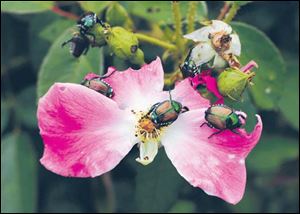
Gardeners fight the annual beetle battle
7/23/2011
Japanese Beetles feast on a rose bush.
Have you seen those fancy green bugs flying around the yard? The Japanese Beetles are in the air and boy are they hungry! Their favorite food? Adults will eat holes in flowers, leaves, and fruit. They feast on roses, raspberries, currants, grapes, peaches, apples, and many other plants.
Adult Japanese Beetles are very pretty. They are only about a half-inch long, but their body is stout. Their shell is a fancy metallic green with copper wings. As you were digging around, you may have discovered them in their larval stage. They are white C-shaped grubs that like to eat the roots of your turf.
If you have a large grub population in your yard, chances are the chemicals you applied this spring to kill the grubs worked on your own lawn. So where are the beetles coming from? The neighbor’s yard. The adult beetles can fly at least half a mile.
They lay their eggs in June and July, usually near the rootline of your grass. In a few weeks, the eggs will turn into grubs that will feed on the roots nearby. It is a big cycle and they want to keep us busy.
Beetle protection
First thing to remember when you think about your beetle battle: They are here to stay, so you will never totally get rid of them. We just have to adjust our habits to include them in our landscape.
If you only notice a few beetles in your landscape, get down on your knees and say a prayer of thanks. While you are down there, just hand-pick those beetles off of your plants to protect them from damage.
Another way to protect your plants from beetle damage is to cover them. You can pull a parachute of nylon netting or polyester row covering over your plants so the light and rain can get in, but the bugs can’t. You can also get tough and spray the area with an insecticide specifically formulated to kill Japanese Beetles that contain chemicals such as Carbaryl, Malathion, Methoxychlor, and Rotenone.
There are also many biological controls on the market that don’t contain chemicals. Look for parasites, nematodes, and fungi to fight them in a natural way.
Bug bags
I’m not a big fan of beetle bags. These traps can be another way to minimize some of the damage they will cause, but they also lure legions of beetles to your yard.
If you read the directions on the label of the trap, it says to put the trap three to five feet high away from their favorite food source. If you put it really close to something they like to nibble on, like roses, you may have more damage to your rose bed because you were luring the beetles right to it.
Traps are baited with the chemicals that make the beetle think it has found the perfect place to eat and mate. Once the pheromone scent lures them in, the trap won’t let them out and they are left there to die with many of their buddies. From June through September, you can catch thousands of them.
The only way the bag treatment will be successful is to get the whole neighborhood involved. One or two traps per acre may have an effect on an area.
Contact Kelly Heidbreder at: getgrowing@gmail.com